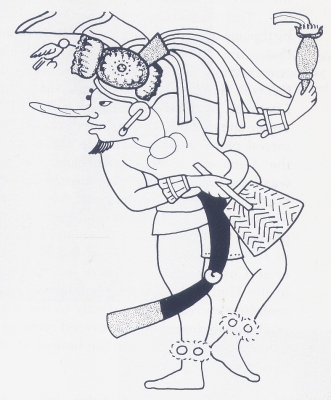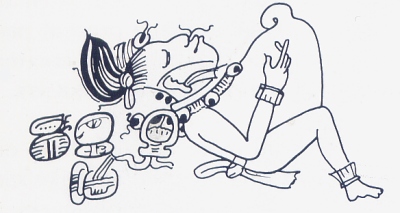



Maya Clown Deity
MAYA CLOWNS
Ritual clowns are widely known in both Colonial and contemporary Mesoamerica. Like the modern Pueblo clowns of the American Southwest, these performers provide both entertainment and biting social commentary. The following is a Spanish description of the early Colonial Yucatec clowns known as baldzam: “They are clever in their mottoes and jokes, that they say to their mayor and judges: if they are too rigorous, ambitious, or greedy, they portray the events that occurred and even what concerns the official’s own duties, these are said in front of him, and at times with a single word.”
But along with being amusing social commentators, the native ritual clowns tend to be endowed with considerable supernatural power. During their performances, the clowns are frequently believed to become particular gods, demons, and other supernatural entities. In addition, through role reversal and inversion, they often seem to embody the chaotic timeless powers from before creation. In Mesoamerica, sacred clowns commonly appear at critical junctures during rites of passage, such as accession to office, or new year celebrations and other calendrical events.
Ritual clowns are commonly depicted in Classic Maya art. Rather than appearing in monumental sculpture, they are usually rendered on small portable objects, such as figurines or vases. They tend to be aged and grotesquely ugly characters, often with animal attributes. In addition, they often appear dancing with fans and rattles – signs of performers. Still earlier ritual clowns appear in the ceramic art of Colima. Dating to the Protoclassic period (100 BCE to 300 CE), these West Mexican sculptures portray rotund ithyphallic characters, animal-masked dancers, and other probable clowns.

The Fat God Deity
THE FAT GOD
The Fat God is among the more curious and least understood deities of ancient Mesoamerica. This strange being is found in the Classic period art of Teotihuacan, Veracruz, and the Maya region. He is first known in Late Formative monumental stone sculpture from the piedmont of Guatemala. Appearing at such early sites as Monte Alto and Santa Leticia, the Fat God is represented as either a huge potbellied figure or simply a massive head. In both cases, he appears much like a bloated corpse with heavy, swollen lids covering his eyes. In the case of potbelly sculptures, the navel too is often large and swollen. The Fat God is a common character among the Late Classic Maya figurines, occasionally occurring also on ceramic vessels where, like the early piedmont sculptures, he is shown with shut eyes and a swollen belly and navel. In two cases, he is accompanied by a Hieroglyphic compound read sidz. The term sidz signifies gluttony in Chol and excessive desire or gluttony in Yucatec. This possible meaning of the Fat God as an intemperate glutton may explain his frequent role as a dancer or entertainer in Late Classic Maya art. He may have been lampooned as a ritual clown character personifying gluttony and greed, major subjects of derision and social condemnation in Mesoamerica.

The source for this article is a wonderfully detailed book, An Illustrated Dictionary of The Gods and Symbols of Ancient Mexico and the Maya by Mary Miller and Karl Taube. A must-have reference book, IMHO.
